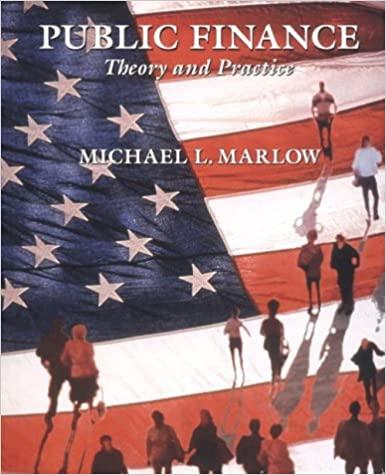Question
The questions that aren't showing are: a. The after-tax cash outflow associated with the lease in year 1 is $__? The after-tax cash outflow associated


The questions that aren't showing are: a. The after-tax cash outflow associated with the lease in year 1 is $__? The after-tax cash outflow associated with the lease in year 2 is $__? The after-tax cash outflow associated with the lease in year 3 is $__?
The after-tax cash outflow associated with the purchase in year 1 is $__? The after-tax cash outflow associated with the purchase in year 2 is $__? The after-tax cash outflow associated with the purchase in year 3 is $__?
b. What is the present value of each (lease & purchase for years 1 - 3) cash outflow steam using the after-tax cost of debt?
c. Would you recommend the lease or the purchase alternative? Why?
Lease Annual end-of-year lease payments of $27,000 are required over the 3-year life of the lease. All maintenance costs will be paid by the lessor; insurance and other costs will be borne by the lessee. The lessee will exercise its option to purchase the asset for $4,000 at termination of the lease. Ignore any future tax benefit associated with the purchase of the equipment at the end of year 3 under the lease option. Purchase The research equipment, costing $65,000, can be financed entirely with a 12% loan requiring annual end-of-year payments of $27,063 for 3 years. The firm in this case will depreciate the equipment under MACRS using a 3-year recovery period. (See E. for the applicable depreciation percentages.) The firm will pay $1,600 per year for a service contract that covers all maintenance costs; insurance and other costs will be borne by the firm. The firm plans to keep the equipment and use it beyond its 3-year recovery period. urance and other costs are borne by the firm under both i Data Table est dollar.) Rounded Depreciation Percentages by Recovery Year Using MACRS for First Four Property Classes Percentage by recovery year Recovery 3 years 5 years 7 years 10 years year 33% 20% 14% 10% 32% 25% 18% 19% 18% 14% 12% 12% 12% 12% 9% 5% 45% Bocovo AWN- 6% 6% 4% Totals 100% 100% 100% 100% *These percentages have been rounded to the nearest whole percent to simplify calculations while retaining realism. To calculate the actual depreciation for tax purposes, be sure to apply the actual unrounded percentages or directly apply double-declining balance depreciation using the half-year convention. a. Calculate the after-tax cash outflows associated with each alternative. (Hint: Because insurance and other costs are borne by the firm under both alternatives, those costs can be ignored here.) b. Calculate the present value of each cash outflow stream, using the after-tax cost of debt. c. Which alternative-lease or purchasewould you recommend? Why? a. The after-tax cash outflow associated with the lease in year 1 is (Round to the nearest dollar.) Lease Annual end-of-year lease payments of $27,000 are required over the 3-year life of the lease. All maintenance costs will be paid by the lessor; insurance and other costs will be borne by the lessee. The lessee will exercise its option to purchase the asset for $4,000 at termination of the lease. Ignore any future tax benefit associated with the purchase of the equipment at the end of year 3 under the lease option. Purchase The research equipment, costing $65,000, can be financed entirely with a 12% loan requiring annual end-of-year payments of $27,063 for 3 years. The firm in this case will depreciate the equipment under MACRS using a 3-year recovery period. (See E. for the applicable depreciation percentages.) The firm will pay $1,600 per year for a service contract that covers all maintenance costs; insurance and other costs will be borne by the firm. The firm plans to keep the equipment and use it beyond its 3-year recovery period. urance and other costs are borne by the firm under both i Data Table est dollar.) Rounded Depreciation Percentages by Recovery Year Using MACRS for First Four Property Classes Percentage by recovery year Recovery 3 years 5 years 7 years 10 years year 33% 20% 14% 10% 32% 25% 18% 19% 18% 14% 12% 12% 12% 12% 9% 5% 45% Bocovo AWN- 6% 6% 4% Totals 100% 100% 100% 100% *These percentages have been rounded to the nearest whole percent to simplify calculations while retaining realism. To calculate the actual depreciation for tax purposes, be sure to apply the actual unrounded percentages or directly apply double-declining balance depreciation using the half-year convention. a. Calculate the after-tax cash outflows associated with each alternative. (Hint: Because insurance and other costs are borne by the firm under both alternatives, those costs can be ignored here.) b. Calculate the present value of each cash outflow stream, using the after-tax cost of debt. c. Which alternative-lease or purchasewould you recommend? Why? a. The after-tax cash outflow associated with the lease in year 1 is (Round to the nearest dollar.)Step by Step Solution
There are 3 Steps involved in it
Step: 1

Get Instant Access to Expert-Tailored Solutions
See step-by-step solutions with expert insights and AI powered tools for academic success
Step: 2

Step: 3

Ace Your Homework with AI
Get the answers you need in no time with our AI-driven, step-by-step assistance
Get Started


